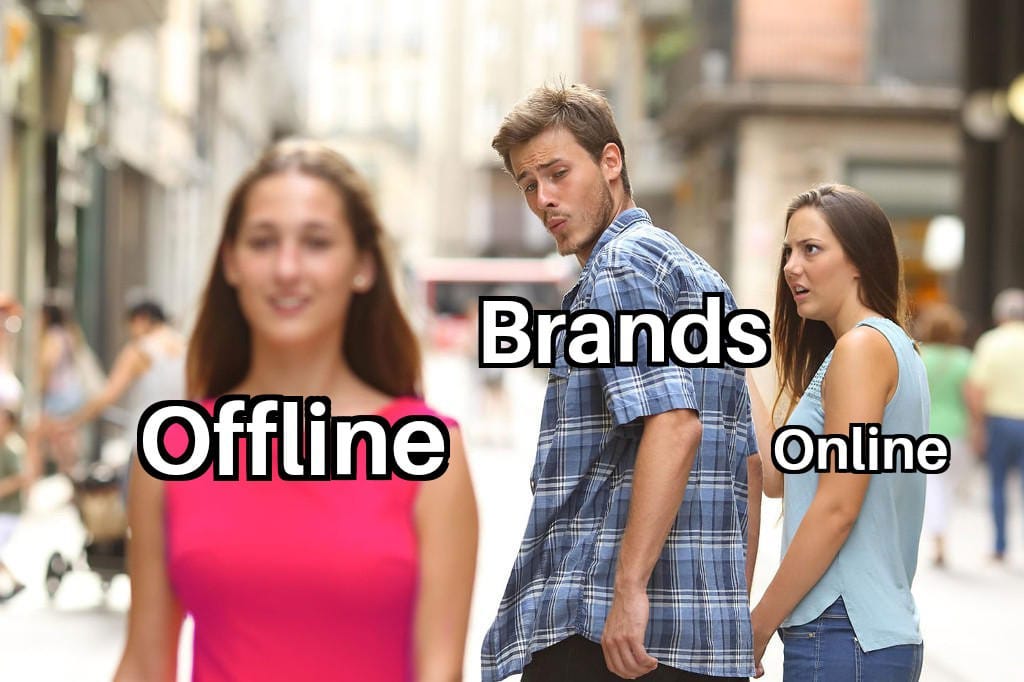“Online meh junoon hai, par offline meh sukoon hai ~ Ae profits hai mushkil ” → Bunny was speaking for brand strategists out there with these lines, because no matter what strategies you deploy to either grow revenue, profits or marketing costs… like Naina said, “kuch na kuch toh chutega hi”. With this context in mind lets us decode saga of online-first brands going offline.
For the past couple of years, we have all heard about the success stories of D2C brands and the e-commerce boon in India. There has been a plethora of online-first companies that emerged since the onset of the pandemic and many even became unicorns backed by growing investor interest. B2C e-commerce companies in India raised $5Bn from PE/VC investors in 2021 alone.
But that’s old news. Latest trend among the digital-first brands is – Expansion into offline space! Yes, you read that right – the race to acquire maximum users per ad-click will now be a fight for shelf space in retail outlets.
Mamaearth, which was the first unicorn of 2022, retailed through 1.12 lakh FMCG retail outlets. The company also launched its first Exclusive Brand Outlet (EBO) in October 2021 and expanded to 35 EBOs in 16 districts across India in less than a year. Revenue contribution from its offline channels has grown from 9% (INR 9 Cr) in FY20 to 35% (INR 26 Cr) in H1 FY23.
BPC e-commerce platform Nykaa has expanded its physical store footprint to 105 stores (32 stores being added in FY22 itself) in 49 cities across India. Nykaa Luxe, Nykaa On-Trend and Nykaa kiosks are part of the company’s targeted efforts to capture the offline market.
Another unicorn club member Licious, which disrupted India’s $50 Bn meat and seafood market through online delivery, is now aggressively pushing its offline presence. The company plans to open 30 experience stores across the country. Its peer, Fresh-to-Home recently raised $104Mn fresh capital to foray into offline space.
Online apparel brand, The Souled Store opened its sixth offline store (a massive 5,000 sqft. outlet in the heart of Bengaluru city) and plans to open 50+ stores within 3 years.
Many other online-first D2C brands like Wakefit.co, Oziva, Plum, mCaffeine, Spice Story are increasingly shifting offline.
The natural question is why these new-age companies, which disrupted the market through their digital-first approach and asset-light models, are resorting to traditional retail?
Let’s dive in to understand some of the key reasons driving this shift…
Customer experience – Many customers look for the experience of touch and feel before buying the product, which is impossible online. In the post-pandemic scenario, there has been a re-emergence of customers in physical retail stores who want to leave home looking for experiential options.
High Customer Acquisition Cost – Online ads on Facebook, Google or marketplaces like Amazon and Flipkart has been the typical mode for acquiring customers online. But off-late these ad-costs have been ballooning.
Brand visibility – Online space has become very cluttered and performance marketing alone is not enough to boost brand presence. Companies end up spending heavily on branding initiatives, whereas offline shelf space offers customers to discover the brand organically.
Better margins – Brands end up offering heavy discounts to tackle the increasing competition on online marketplaces. Higher spends on performance marketing and branding result in lower margins on online channels as compared to offline channels despite factoring in distributors’ and retailers’ share.
Although, the four reasons listed above are actually the outcomes driven by a more prominent and larger issue i.e., actual market size for online retail in India.
In developed economies like the USA, online retail accounts for ~22% of the total retail market; however, online retail penetration in India is as low as 5%. This may sound unbelievable initially, especially if you have read the recent news articles which went gung-ho over India having the third-largest online shopper base and expected to overtake the USA in 1-2 years.
While it's factually correct, it is not the complete picture. The relevant Bain & Co report on “How India shops online 2022” also states that India’s shopper base of 180 Mn in 2021 is expected to increase to ~450 Mn users by 2027 and at that point (over the next 5 years) e-retail market penetration would reach around 9-10%.
India has 800 million smartphone users and ~500 million social media users while the online shopper base is only 180 million (which in fact includes occasional shoppers and people who shop once in a blue moon or only purchase important items for value deals). The strength of active internet shoppers would be much lower – and this is the pie every internet company fought for in the online market. Eventually, resulting in high customer acquisition costs and limitations in scaling beyond a point.
India has largely been an offline-dominated market as the majority of consumers still prefer shopping conventionally through physical stores. Post-pandemic, as customers returned to brick-and-mortar stores, online brands quickly realized that offline strategy is critical to truly capture India’s consumption story to reach a broader customer base. A strong retail distribution network can, in fact, be a powerful MOAT for consumer brands in India (especially in the FMCG category).
During the pandemic period, there was a flurry of companies moving online, in the post-pandemic scenario, it's safe to say that the reverse is in play. While the offline channel is lucrative, it comes with its own set of challenges (substantial investments in infra, logistics management, establishing relationships with distributors/retailers). It would be interesting to see how these new-age companies tackle these challenges and compete with established players on their turf!
Author: Mitali Srivastava
End movie credits:
Chief Editors: Hanu Bansal & Tushar Khandelwal
Consumer Avengers: Amay, Akhil, Arnim, Chirag, Shashank, Mukund, Pranav and Nakul.






